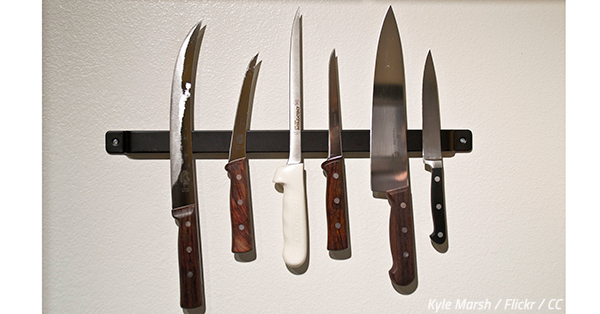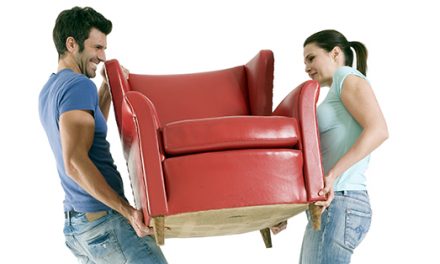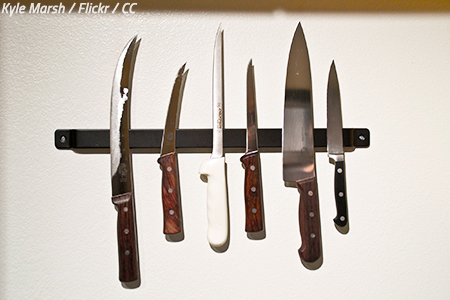 Your decision to pack up your things without relying on professional packing services should be made after a careful analysis of the pros and cons of hiring packers to pack up your home for you.
Your decision to pack up your things without relying on professional packing services should be made after a careful analysis of the pros and cons of hiring packers to pack up your home for you.
And, mind you, once you make up your mind that you will tackle the tough job on your own, it’s time to roll up your sleeves and get to work.
Your personal Packing Timeline should remind you that you are supposed to pack up the kitchen with priority. Why? A kitchen often proves to be one of the most difficult rooms to pack for moving, so you want to start packing from those tough-to-pack premises first while you still have the energy and motivation.
All in all, there are two major challenges when packing a kitchen for a move: 1) it simply contains too many items to begin with, and 2) most of those kitchen items are super-fragile so they need special packing techniques to survive the relocation unscathed.
Sooner or later, you will get to pack your kitchen knives and when you do, you’re likely to wonder about how to safely pack knives for moving due to their sharp, open blades. Despite the dangers of packing knives for a move, you should be able to tackle the packing task safely by following the practical tips below.
So, what’s the safest way to pack kitchen knives for moving?
Dangers of packing kitchen knives for moving
Before you begin to pack up your kitchen knives, it’s important that you understand the risks of handling sharp knives of various sizes and lengths.
1. Risk of injuries
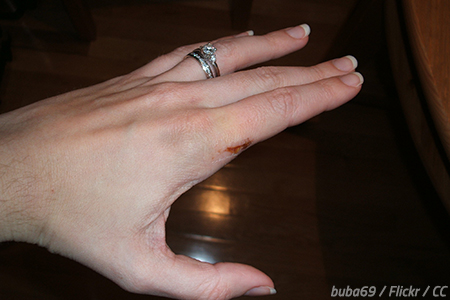
Be very careful not to get a finger cut when you’re packing your kitchen knives.
You should keep in mind that there’s always a danger of getting injured – most often an accidental cut on one of your fingers or on your palm – while packing up or unpacking sharp kitchen knives with open blades.
During the packing process, you have to be extra careful not to cut yourself with any of the kitchen knives. Needless to say, rule #1 when packing knives for moving is to only hold those cutting tools on their handles
Another way can hurt yourself when packing kitchen knives for a move is to accidentally drop a sharp knife onto your feet. You can easily avoid such an accident by first wearing closed shoes and then managing the packing action in the middle of the kitchen table so that it won’t be possible for a knife to fall down on the ground.
2. Risk of property damage
Another danger associated with improper packing of kitchen knives for moving is the possible infliction of some sort of property damage. How?
When the knives are packed incorrectly inside a cardboard box, they can cut through the cardboard, which in turn can cause extra damage to an adjacent box or a piece of furniture while the problematic container is being transported inside the moving vehicle.
Be mindful that an open blade (or blades!) sticking outside a moving box can cause various types of property damage with various levels of severity.
What to Pack First When Moving
Necessary materials for packing knives
Of course, you’re going to need to have the right materials in order to pack your knives safely for the upcoming relocation.
What are the supplies you’ll need to pack sharp kitchen knives?
- Packing paper. You’re going to need many sheets of wrapping paper to ensure the safety of those blades. Make sure you’re using white, soft packing paper that’s both ink-free and acid-free.
- Bubble wrap. The sheets of bubble wrap will create soft padding around the sharp blades and edges of kitchen knives, thus forming a protective layer that should guarantee the safety of the entire packing operation.
- Small or medium boxes. You’re going to need one or two small or medium cardboard boxes depending on the number and size of kitchen knives you’ve decided to move with you.
- Packing tape. Get a roll of quality packing tape for all your packing needs. If you have a knife block, then you may need a bit of painter’s tape to secure the knives onto the block prior to packing.
- Markers. A black marker pen should be enough to label properly the boxes.
Preparation before packing your knives
There are a few preparatory steps before you can actually begin wrapping up your knives. These pre-pack tasks will ensure the safe and quick completion of the packing job – exactly the thing you’re after, right?
1. Inspect all knives before packing

Make sure you’re not taking any knives you won’t really need after the move.
It makes little sense to pack and move knives that you won’t use for various reasons. So, take a few minutes to inspect each knife carefully in order to determine whether it’s really worth packing and moving it in the first place.
If a knife has a broken handle or a chipped blade, then you may decide to leave it behind.
If a knife has served you well for many years but it’s seriously worn out, then the house move is a good pretext to replace it.
Generally speaking, consider throwing away any knives with some sort of damage on them that has rendered them unusable.
After all, isn’t a brand-new set of kitchen knives the perfect gift for the new home?
2. Clean the knives
This is a pretty simple step – it’s not a good idea to pack dirty knives so take a moment to clean the ones you’re about to pack up.
If a particular kitchen knife is stained rather than dirty, then you should consider throwing it away… unless it has some sort of sentimental value for you.
3. Organize the knives by size
This sorting step will facilitate the entire process of packing kitchen knives for moving. All you need to do is sort out all the knives you’re taking with you according to their size.
How will that help you to pack your knives more efficiently?
Having knives with similar or identical lengths will enable you to wrap and bundle the kitchen cutting tools much more quickly and safely. The resulting paper bundles will be tighter and more secure.
Bread knives and chef knives are usually similar in size, as well as utility knives and paring knives on one side, and boning knives and filleting knives on the other side.
4. Prepare the boxes
The cardboard boxes you plan to use for your kitchen knives should only be used for that very purpose. In other words, you’re not recommended to pack anything besides knives inside those containers for safety reasons – in case a blade does manage to cut through the paper + bubble wrap bundle.
Place pieces of crumpled paper on the bottom of the boxes to form a soft cushioning layer that will add an extra degree of protection.
How to pack knives for moving: Step-by-step guide
By now you should be ready to pack your knives safely for transport. Follow the detailed packing steps below to do it quickly and easily as well.
-
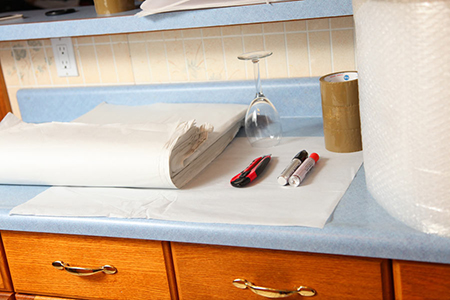
Packing paper and bubble wrap will be your best allies when packing knives.
Step 1. Position the stack of packing paper in the center of the kitchen table – that will be your packing station. In case the table is unavailable, then you can use the kitchen counter for the purpose.
- Step 2. Take one knife from a group of similar kitchen knives and position it at an angle close to the edge of the top sheet of paper.
- Step 3. Grab three paper sheets at the same time from the edge of the stack and roll the sheets over the kitchen knife several times until the kitchen item is completely wrapped in packing paper.
- Step 4. Position another knife from the same group to the one that’s already covered in paper. Make sure the open blade of the second kitchen item is placed in the opposite direction of the first piece.
- Step 5. Continue to roll the wrapping paper over the second piece until it is also completely covered by the soft packing material.
- Step 6. Add to the bundle a third knife of a similar size. This time, ensure its blade is positioned in the opposite direction of the second cutlery piece.
- Step 7. Roll the paper over the third kitchen knife until it gets completely covered in white, ink-free wrapping paper.
- Step 8. Consider adding a fourth and even a fifth knife if the space allows it. If not, you should follow the necessary steps to finish and secure the paper bundle.
- Step 9. Complete the paper bundle by tucking in the ends of the stack.
- Step 10. Use pieces of packing tape to secure the paper bundle.
- Step 11. Add one final layer of bubble wrap over the secured paper bundle. Again, use tape to fix the bubbly plastic material – this way, no knife should be able to cut through the multiple sheets of paper.
- Step 12. Transfer the ready bundle into the box.
- Step 13. Start rolling up another paper bundle of similar kitchen knives. Remember to alternate the directions of the blades of the knives you add.
- Step 14. Keep repeating the above packing steps until you’re done. All in all, you should get between 3 and 5 bundles altogether depending on how many knives you’ve decided to move to the new home.
- Step 15. Arrange the paper-plus-bubble wrap bundles in the box, then fill in any gaps between them using pieces of paper – newsprint is fine too.
- Step 16. Close the lids of the box and tape them shut securely.
- Step 17. Label the box KNIVES and KITCHEN.
How to Pack a Kitchen When Moving
How to pack a knife block for moving
If you have a knife set that’s arranged in its own knife block, then you can use a cute packing tactic and pack the entire block, together with the kitchen knives.
Here’s how you should do it:
-
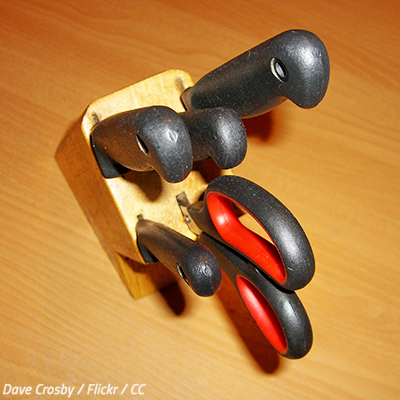
Packing the entire knife block is the easiest and fastest way to pack knives when moving to a new home.
Step 1. Secure each individual knife in its own block slot using pieces of painter’s tape. Avoid using regular packing tape since it’s likely to leave unpleasant tape residue marks. The idea is to make sure the knives won’t slip out during transport.
- Step 2. Wrap the entire knife block in several sheets of packing paper. Secure the paper with the help of packing tape.
- Step 3. Add a couple of sheets of bubble wrap over the initial paper layer. The bubble wrap will provide an extra level of protection for the entire kitchen item. Use pieces of tape to fix the plastic material in place.
- Step 4. Transfer the wrapped-up knife block into a pre-padded box. It’s OK to pack it inside a box together with other bundled kitchen knives.
While you should be able to pack your kitchen knives for moving on your own, you must observe the safety measures described above. If you feel nervous about getting hurt while handling the sharp blades of those kitchen knives, or if you’re running out of time, then do the sensible thing and hire professional packers to help you out.

